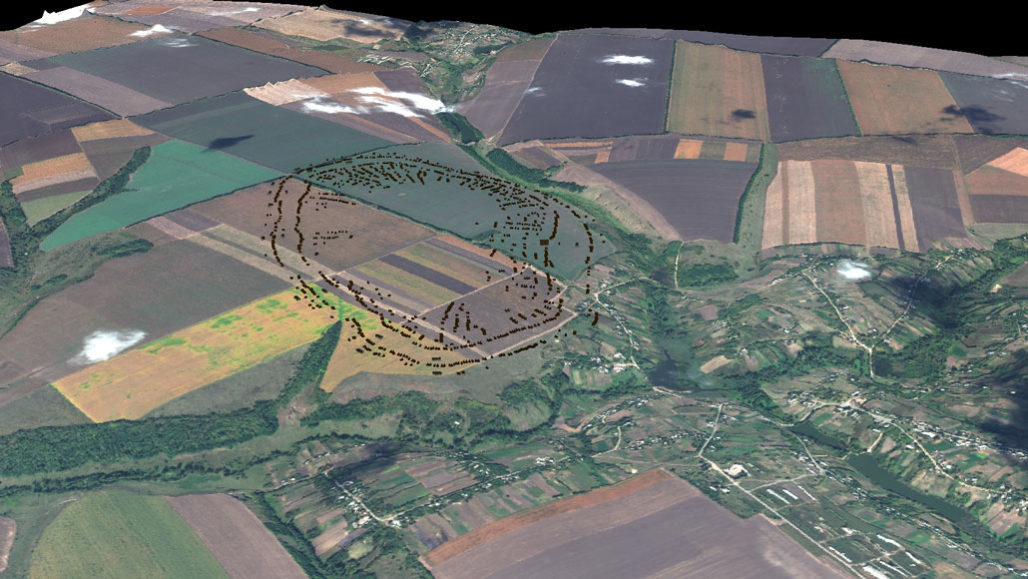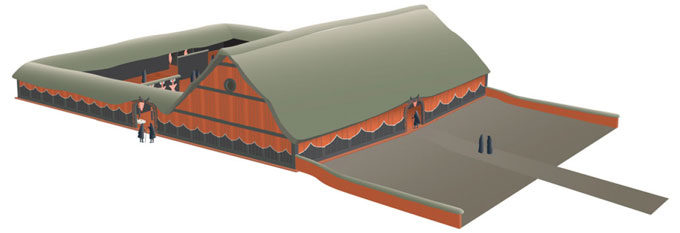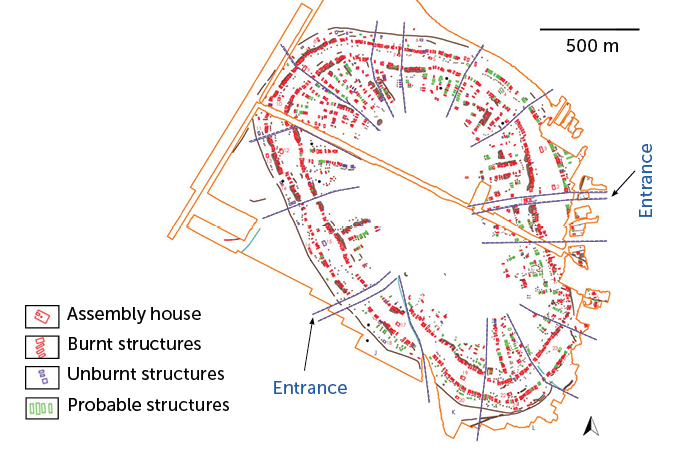
It wasn't always so. Beneath the surface of Nebelivka's surrounding landscape and at nearby archaeological sites, roughly 6,000-year-old remnants of what were possibly some of the world's first cities are emerging from obscurity. These low-density, spread-out archaeological sites are known as megasites, a term that underscores both their immense size and mysterious origins. Now, some scientists are arguing the settlements represent a distinct form of ancient urban life that has gone largely unrecognized.
Megasites were cities like no others that have ever existed, says archaeologist John Chapman of Durham University in England.
For decades, researchers have regarded roughly 6,000-year-old Mesopotamian sites, in what's now Iraq, Iran and Syria, as the world's first cities. Those metropolises arose after agriculture made it possible to feed large numbers of people in year-round settlements. Mesopotamian cities featured centralized governments, bureaucratic agencies that tracked and taxed farm production, and tens of thousands of city dwellers packed into neighborhoods connected by dusty streets. Social inequality was central to Mesopotamia's urban ascent, with a hierarchy of social classes that included rulers, bureaucrats, priests, farmers and slaves.
Over the last decade, however, researchers have increasingly questioned whether the only pathway to urban life ran through Mesopotamian cities. Chapman, along with Durham colleague Marco Nebbia and independent, Durham-based scholar Bisserka Gaydarska, is part of a movement that views low-density, spread-out settlements in several parts of the world as alternative form of early city life.

Megasites may have been built so that people could better defend against invasions by rival villages or foreign forces. Based on that assumption, some estimates of population at these places run into the tens of thousands. But recent work by Chapman, Nebbia and Gaydarska indicates megasites in general may have had only a few thousand inhabitants.
And Nebelivka appears to have lacked a class of elites ruling over hordes of common folk who did the dirty work. Instead, excavations suggest that the site was organized to promote shared rule among groups of equal social standing. Thus, Nebelivka demonstrates that urban development doesn't automatically split people into haves and have-nots, Chapman and colleagues argue, a common assumption among those concerned about social and economic inequality in modern societies.
Nebelivka novelty
In the 1970s, archaeologists began excavating several Trypillia megasites in fertile soil between the Southern Bug and Dnieper rivers in Ukraine. Aerial photography and geomagnetic surveys on the ground revealed outlines of buried structures. At least two dozen megasites have been located in the country since then.
Ukrainian archaeologists have excavated small parts of several of the sites. But it's a daunting task. Researchers working at one location have unearthed about 50 houses over the last 25 years, Chapman says. "They have another 2,150 houses to go."
At Nebelivka, Chapman, Gaydarska and Nebbia have reconstructed the megasite's entire layout. This settlement blueprint, the first of its kind for a megasite, appears in the February Cambridge Archaeological Journal.
Over six years of fieldwork since 2009, the researchers have excavated and mapped Nebelivka structures located over more than a square kilometer. Aerial photos, satellite images and geomagnetic data, supplemented by excavations of 88 test pits, identified 1,445 residential houses and 24 communal structures dubbed assembly houses. Residential houses, some intact and most in ashes after having burned, were grouped into 153 neighborhoods, a majority containing three to seven houses. Neighborhoods, in turn, formed 14 quarters, each with one or more assembly houses situated in an open area.

In 2015, the researchers built and then burned a replica of a Trypillia house, producing lumps of ashy clay residue like those found where actual Nebelivka houses once stood. Only after filling the replica with much more dry timber than had been used to build the house did the experimental conflagration reach temperatures high enough to raze the entire structure and produce Nebelivka-like residue mounds. Nebelivka's ancient residents must have gone to great lengths to gather enough wood for what was likely ceremonial house burnings, Chapman says.
"Burning a house down in this way created a spectacle that could be seen from many kilometers away," he says.

Although Chapman and colleagues agree Nebelivka's city life differed from that of Mesopotamian metropolises, the researchers disagree about the details.
Chapman suspects the megasite was a permanent settlement in which, at any one time, 2,000 to 3,000 people occupied up to 400 houses. Residents likely came from 10 regional groups, known from previous investigations of smaller Trypillia villages, that had traded goods and formed some common cultural beliefs and practices, he says. Members of the 10 groups established the neighborhoods and quarters outlined in Nebelivka's site plan, Chapman speculates. Given the need to ease inevitable tensions among groups living unusually close together, a council recruited from throughout Nebelivka may have made political decisions. Council leadership might have even shifted annually from one group to the next, he says.
Nebbia thinks it's more likely that perhaps 3,000 to 4,000 people inhabited Nebelivka for around one month each year. During that time, people who assembled at the megasite made new contacts, shared knowledge and goods, and conducted communal activities such as house building and burning. Perhaps 100 to 150 guardians lived at and maintained Nebelivka year-round, he speculates.
Yet another possibility, favored by Gaydarska, portrays Nebelivka as a large center for religious pilgrims from throughout the Trypillia world. Over a roughly eight-month pilgrimage season, presumably scheduled for seasons when the weather permitted long-distance journeys, between 1,000 and 2,000 pilgrims per month inhabited Nebelivka. Ritual leaders from various Trypillia communities maintained the settlement and organized construction projects, she suspects, including the raising of assembly houses where religious ceremonies were held.
Middle Eastern sites for large, periodic gatherings date back at least 10,000 years and could have set the stage for similar but larger get-togethers at Nebelivka, however they were organized, Gaydarska says. While Nebelivka's site plan can't unveil the exact nature of social life there, it reveals a large open space in the center of the megasite where researchers previously assumed many people lived. Earlier estimates that Nebelivka housed 10,000 people or more are thus way too high, the three researchers contend.
Power sharing
As at Nebelivka, an increasing number of archaeological sites in Asia, Europe and the Americas are being classified as low-density urban settlements, says archaeologist Roland Fletcher of the University of Sydney. For instance, settlements comparable in size and population to megasites, known as oppida, emerged elsewhere in Europe more than 2,000 years ago. Whether people inhabited oppida year-round or seasonally, these sites contained households of roughly equal status that participated in collective decision making, Fletcher says.

Councils of social equals governed many of the world's earliest cities, including Trypillia megasites, Wengrow contends. Egalitarian rule may even have characterized Mesopotamian cities for their first few hundred years, a period that lacks archaeological evidence of royal burials, armies or large bureaucracies typical of early states, he suggests.
Megasite mystery
Not everyone views Nebelivka as emblematic of an alternative branch of early city life.
"Nebelivka may be an interesting example of a ritual, ceremonial or defensive gathering place rather than an 'all-purpose' city or a distinctive pathway to urbanism," says archaeologist Monica Smith of UCLA.
Unlike bustling Mesopotamian cities, which featured walls or other prominent structures along their borders, Nebelivka contained lots of apparently open space and was encircled by only a ditch, Smith observes. And from the start, cities brought together large numbers of people who had to cooperate with strangers and heed the edicts of political and religious leaders, Smith argues. Ancient cities typically included massive official structures and were densely occupied for thousands of years, unlike megasites that drew smaller crowds for several hundred years at most, she says. Smith reserves judgment on the nature of city life at Greater Angkor and the Maya sites, where further excavations might reveal higher-density occupations than currently suspected.

But Nebelivka and other Ukrainian megasites transcended Trypillia village life too dramatically to be classified simply as gathering places, Gaydarska argues. Trypillia people, she maintains, engaged in one of several early experiments in large-scale urban living, even if for only part of the year. It's time to revamp traditional ideas of what makes an ancient settlement a city, she says.
For now, the next challenge is to explain why the Tyrpillia megasites arose in the first place and lasted no more than around 700 years. To get a better grip on that mystery, Gaydarska plans to excavate Trypillia villages dating to just before and after Nebelivka's heyday. "We have nothing to compare Nebelivka to at this point," she says.
Citations
B. Gaydarska, M. Nebbia and J. Chapman. Trypillia megasites in context: independent urban development in Chalcolithic Eastern Europe. Cambridge Archaeological Journal. Vol. 30, February 2020, p. 97. doi:10.1017/S0959774319000301.



Human immolation: [Link]
Gut bacteria? Brewed beer consumption? Radon excess in the environment? An undiscovered source of electrons such as noted on the suspicious observers site 2/20/2020? Cosmic alignments?
Left over hands and feet even tho reported and confirmed temps of 3500 degrees?